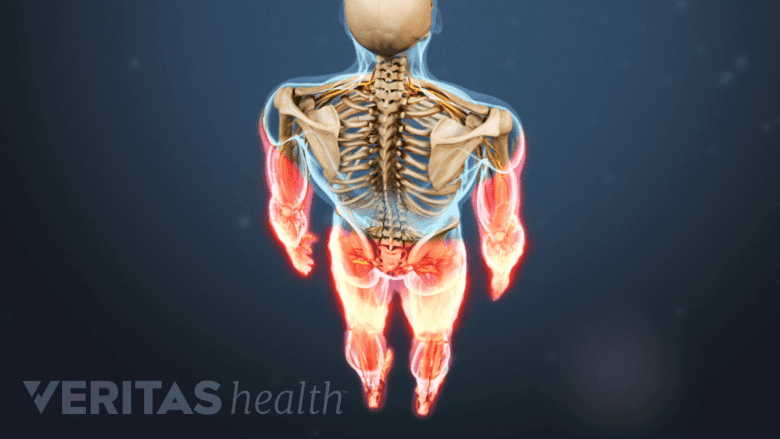A neck strain occurs when one or more fibers in a neck muscle or tendon stretches too far and tears. This injury, also called a pulled muscle, can vary in intensity depending on the tear’s size and location. While a neck strain typically heals on its own within a few days or weeks, the pain may range from mild and achy to sharp and debilitating.
Sometimes the terms neck strain and neck sprain are used interchangeably. While a sprain is an injury to a ligament (not a muscle or tendon), the symptoms of pain and stiffness felt in both a strain and sprain are typically similar and resolve on their own before an official diagnosis is sought.
In This Article:
Neck Muscle Function and Strain
More than 20 muscles are connected in the neck. These muscles work together to help support the head’s upright position and facilitate movements of the head, neck, jaw, upper back, and shoulders
Watch Cervical Muscle Anatomy Animation
A healthy muscle is comprised of numerous muscle fibers. Within each of these fibers are bundles of myofibrils that contain contractile proteins, which perform the actual contractions for muscle movements. When the muscle overexerts or stretches too far, small tears can form in the muscle, tendon, or connective tissue between the muscle and tendon, which is usually the weakest part.
More extensive neck strains involve more inflammation, which leads to more swelling, pain, and a longer recovery period. The strained muscle’s strength while the injury is healing largely depends on how many muscle fibers were torn.
Two long neck muscles that are at an increased risk for strain are:
Levator scapulae. This muscle travels down the side of the neck, from top of the cervical spine to the scapula (shoulder blade). The levator scapulae plays a key role in bending and rotating the neck to the side, and these movements can be hindered if the muscle is strained.
- Trapezius. This kite-shaped (trapezoidal) muscle runs from the base of the skull and goes more than halfway down the back, as well as out to the shoulders. The upper trapezius muscle helps facilitate many movements, including head tilts and neck extension (looking up).
Other neck muscles can also become strained, and it is possible for more than one neck muscle to become painful at the same time.
Causes of Neck Strain
Some common causes of neck strain include:
Poor posture or holding an awkward position

Poor posture, repetitive movements, and strains may all cause neck pain.
The neck’s muscles, tendons, and other soft tissues can become overstretched when the head is held too far forward or tilted at an angle for too long. Some examples include being hunched over a computer for several hours, holding the phone between the ear and shoulder, or sleeping in a position that does not support the cervical spine well. An increasingly common problem is text neck, which describes neck pain that is caused by looking down at a phone screen or other wireless device for too long or too frequently.
Watch Text Neck Symptoms and Causes Video
Lifting something too heavy
It is likely for the neck to become overexerted and strained when lifting something that requires too much work for the muscles.
Collision or fall

A sudden impact can cause the head and cervical spine to move too rapidly, resulting in neck strain.
A sudden impact can jar the head and cervical spine to move too quickly for the muscles, which may lead to whiplash or other types of neck strain injuries. Some examples include auto accidents, bike accidents, or sports injuries, such as in football.
Watch Whiplash Video
Performing a new activity

Muscle strains are likely among athletes at the onset of a training season.
Putting any muscle through a new type of activity that is somewhat strenuous makes it more susceptible to strain, including in the neck. For instance, athletes are more susceptible to muscle strains at the beginning of a training season. 1
Repetitive motions
Even for motions and loads that neck muscles can handle, doing too many repetitions can eventually strain the muscles.
This is not a complete list of neck strain causes. Sometimes the exact cause of a neck strain is not known.
The Course of Neck Strain
A neck strain may be painful as soon as the injury occurs, or it may take many hours for the inflammation to increase and symptoms to appear. Sometimes the symptoms start so gradually that it is difficult to trace how or when the injury occurred. Typically, neck strain pain and stiffness continue to worsen during the first day or two after the injury.
See Treatment for a Stiff Neck
While most neck strains take a few weeks to completely heal, symptoms tend to mostly go away in less than a week. In general, severe muscle strains tend to take closer to 12 weeks to heal, but these rarely occur in the neck without the involvement of a more serious injury.
When to See a Doctor for Neck Strain

Pain accompanied by numbness or tingling in arms and legs requires immediate medical attention.
For most episodes of neck strain, self-care and avoiding any additional strain to the neck is enough to manage symptoms until the injury is healed. Medical attention should be sought if the initial injury was part of a major trauma (such as a car crash or fall from height), has worsened or not improved within a few days, or is accompanied by troubling symptoms, such as numbness or tingling in the arm, weakness in the arms or legs, or difficulty with balance.

